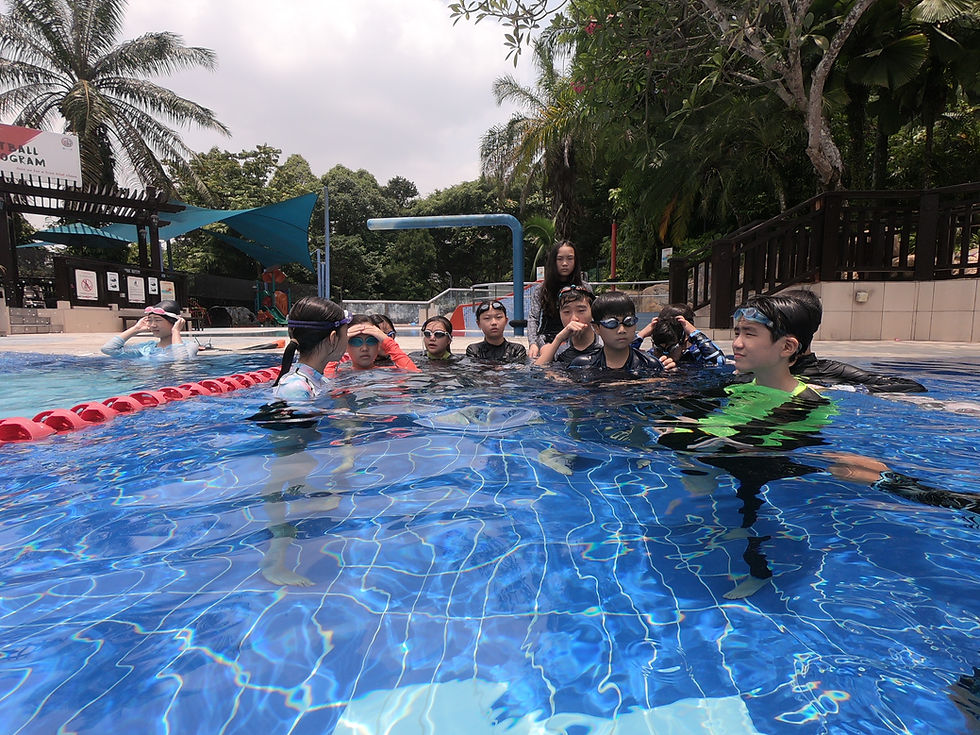Using Swim Games to Engage Kids With ADHD
- SG Sink Or Swim

- Jul 25
- 3 min read

Swimming is not just a great physical activity — it’s also a powerful tool for supporting children with Attention Deficit Hyperactivity Disorder (ADHD). But to truly connect with ADHD learners, swim instruction needs to go beyond traditional drills. Play-based learning, using games that build skills while embracing movement and fun, is one of the most effective ways to keep kids with ADHD engaged and progressing in the water.
In this article, we explore how to use swim games strategically to support attention, confidence, coordination, and water safety for children with ADHD.
🧠 Why Swim Games Work for Kids With ADHD
Children with ADHD often struggle with sustained attention, impulse control, and hyperactivity. Swim games:
Turn learning into fun challenges
Keep lessons dynamic and varied
Encourage movement and focus at the same time
Build social interaction and cooperation
Offer immediate sensory feedback, which is calming and grounding
✅ The right game can make learning feel like play while still reinforcing swimming fundamentals.
🏊♀️ Game-Based Strategies to Support Swim Skills
Here are targeted swim games that support key skill areas for ADHD swimmers:
1. “Red Light, Green Light – Swim Edition”
Purpose: Teaches impulse control and body awareness.
How to play:
Swimmers move forward (kicking or swimming) on “green light”
They must freeze on “red light” — no splashing or moving
Vary commands with arm strokes, kicks, or floating
✅ Helps practice stopping and starting, listening to cues, and staying in control.
2. “Treasure Hunt”
Purpose: Builds underwater confidence and object retrieval.
How to play:
Scatter dive rings or toys at shallow depths
Set a timer or create teams
Encourage breathing control and focus during retrieval
✅ Supports visual tracking, focus, and breath-holding in a fun way.
3. “Shark Tag” (Instructor or peer as shark)
Purpose: Builds spatial awareness and quick reaction time.
How to play:
One swimmer is the “shark” and chases others in a defined zone
Tagged swimmers can freeze, float, or swim backward to escape
✅ Develops agility, direction changes, and attention to surroundings.
4. “Noodle Joust”
Purpose: Encourages balance, core strength, and social interaction.
How to play:
Swimmers sit on pool noodles and try to unseat each other with soft bumps
Focus on staying upright and maintaining posture
✅ Improves body control and builds friendly competitiveness.
5. “Simon Says: Swim Style”
Purpose: Improves instruction-following and stroke recognition.
How to play:
Instructor calls out swim tasks: “Simon says kick,” “Simon says float,” etc.
Add misdirection to challenge listening skills
✅ Reinforces stroke techniques while training executive functioning.
6. “Obstacle Course”
Purpose: Combines coordination, sequencing, and skill transitions.
How to play:
Set up a course with floating hoops, kickboards, diving toys, and walls
Give each child a sequence: kick → glide → retrieve ring → climb out
✅ Supports multi-step direction following and builds stamina.
🛠 Tips for Running Effective Swim Games With ADHD Kids
🔁 Rotate activities every 5–7 minutes to match attention spans
🎯 Set clear rules and repeat them often
🙌 Celebrate effort more than outcome
🧠 Offer choices to give a sense of control
⏱ Use visual timers or countdowns to help with transitions
🧍♀️ Incorporate movement breaks out of the water if needed
🤝 Pair cooperative games with solo skill time to balance social load
💬 Parent & Coach Pro Tip:
Always preview what’s coming next. Whether it’s a drill or a game, knowing the “what” and “why” reduces anxiety and builds trust in the learning environment.
🏁 Final Thoughts
For children with ADHD, swimming is more than a sport — it’s a sensory-rich outlet for focus, movement, and confidence. By incorporating structured, purposeful swim games, instructors and parents can turn lessons into moments of joy and learning.
Every splash, giggle, and challenge mastered through play brings kids closer to safety, independence, and self-belief in the water.





Comments